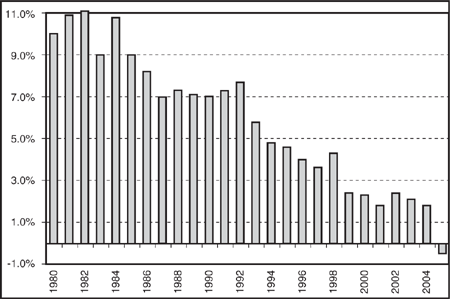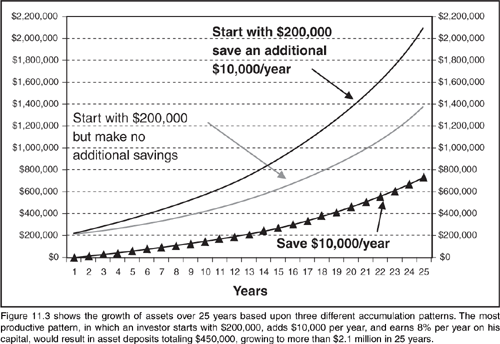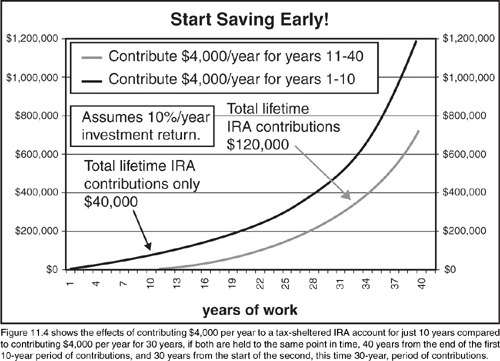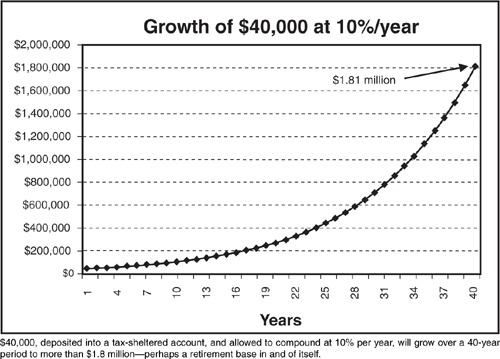The political powers appear to be masters at putting off until tomorrow what should be dealt with today. If federal, state, and city pension funds employ dubious accounting assumptions to avoid confrontations with statistical reality, then those dubious accounting assumptions will be accepted by our leaders as reality.
Is this because government leaders at all levels are unaware of the consequences? Or because they are financially inept? Or both? Actually, probably neither of the above.
They simply want to be re-elected. Raising social security taxes today to build up the trust fund for years down the road would be unpopular. So would cutting current benefits, though this has been done indirectly by changes in the tax laws such as the one that made social security payments subject to income taxes and by setting back the age at which full benefits start. Demanding that powerful city unions agree to reduced pension benefits or to reductions in salary to provide ongoing capital for large retirement benefits would, in many cities, be considered political suicide. In New York City, for example, mayors rarely challenge the powerful teacher, police, or firemen unions. Similarly, raising municipal taxes to meet the costs of city worker benefits would probably be political suicide as well. It is definitely easier to sweep the problems under the rug to be dealt with by some future administration.
An airline 30 years ago came up with a marketing campaign for vacationers to fly today and pay tomorrow. It had a snappy ring to it, but was that such a good idea, encouraging people to borrow to take vacations? As life has evolved in the United States (and elsewhere), flying today, paying tomorrow has become the norm rather than the exception. Question: How many of your purchases are paid with cash, by check, or by credit card? If you are like many people, you probably pay cash for only relatively minimum purchases—for food, perhaps, or for subway fares and taxi rides.
Longer trip expenses, restaurant meals, clothes, theatre tickets, significant appliances, jewelry, medical bills—you name it—are probably being paid by credit card, which has also become the coin of the realm for the ever-mounting percentage of purchases made over the Internet.
There are some good reasons to use credit cards instead of paying by cash, or perhaps to a lesser degree, paying by check.
Credit cards enable people to shop without carrying a lot of cash, which most of us prefer not to do. Leaving large amounts of cash at home is safer, so to that extent, the use of credit cards is reasonable. Credit cards are more convenient than paying by check. Credit card companies provide you with a list of transactions you have made and to some degree maintain your books and records. There are fewer purchases to enter into your check records for balancing. Perhaps convenience is one logical justification for the use of credit cards.
Of more psychological significance perhaps, the use of credit cards provides a sense of magic by encouraging denial of the fact that we will, in the end, have to produce real money that really has to be earned at some point to pay for the purchase that we have just made with a quick signature. The magic of being able to buy at whim just by signing their name on a receipt encourages consumers to deny the actual cost of what they are buying, to minimize the need to think about, to save up for, and to delay expenses for which they might not have cash on hand. For a “mere” 16% or more in interest payments, credit cards provide a feeling of plenty, encouraging impulsive, unnecessary expenditures with only one month-end reckoning.
Here’s a quick test.
Try to recall a recently made purchase of a not altogether essential but desired item for which you paid by credit card.
Think, if you can, of your state of mind at the time. Would you have made the same purchase if you had to pay by writing out a check?
Would you have made the same purchase if you had to pay with actual, real, green dollars—counting out bill by bill the amount that you were spending? Would the purchase have seemed more expensive if you had paid by cash?
Would almost all purchases seem more expensive if you were to pay by cash?
Would you have left the same tip at your last restaurant meal if you had left the tip in cash on the table rather than as a credit card addendum to the restaurant bill? (Restaurants rarely ask any more for tips to be left on the table.)
In how many ways, how many times, in making a choice of a credit card purchase, do you choose a more-expensive rather than less-expensive option? Would you make the same choices if you were paying by cash rather than by credit card?
Businesses know the answers—which is why it is a rare business indeed, nowadays, that does not have a credit card machine at the handy ready.
I’m sure you’ve guessed it. Simply, pay with cash, not by credit card, wherever and whenever possible. See how much more frequently you re-evaluate your purchases before buying. See how much more your shopping is controlled. See how much money you actually save by reducing impulse buying.
See how much you can save in interest by deferring purchases until you actually can pay cash for them. Credit card interest charges do add considerably to costs of living, by promoting impulse buying and by promoting the use of high-cost credit to do so. Is it really worth it to pay 16%–20% (plus late charges) more for what you buy just to buy sooner?
At the time that you consider the purchase of something, simply ask yourself how many hours did you or will you have to work to earn the money required for the acquisition.
The answers will vary, of course, with your income level. Some people have high incomes—really high incomes. Between these incomes and possibly accumulated assets, there may be only relatively minimal restrictions on what they can afford to spend, in addition to which they have the ability to pay credit card bills immediately, thereby avoiding interest charges. Most people, however, may find that the question will actually make them reconsider purchases when the price is measured not just in money but also in the expenditure of actual labor to earn that money.
For example, you want a new designer sweater, which costs $400 after-tax money. You make $52,000 per year, about $1,000 a week before taxes. You will have to work just about three days to earn the $600 pre-tax dollars that the sweater, at a price of $400, will cost in after-tax dollars. Three days of riding the subway or bus or driving in the rush hour, three days of dealing with your boss, and three days of handling customers, clients, or computer. Think about it. Do you really still need or still want that sweater?
Some of us are fortunate enough to earn sufficient money from our jobs, businesses, or, perhaps, inherited wealth and assets, to be able to afford almost any conceivable desire without having to calculate its cost in terms of labor required or to have to consider less-expensive alternative purchases.
Most families or people, however, are not quite that fortunate and do have to make choices—purchase this or do that, buy now or wait until later, expand the house or take a vacation, send children to state schools to save on tuition costs or seek out a private university, spend the higher amount or reserve something for your saving and accumulation program. As you shall see, the earlier you start, the more readily you can accumulate the assets required during your later years, as well as assets that may be needed to pay for more current family expenses such as your children’s education.
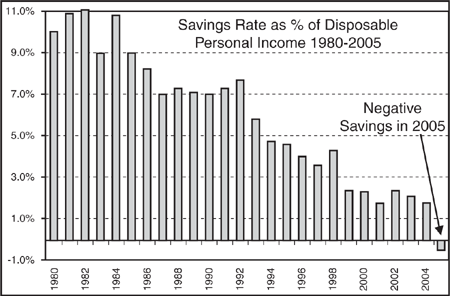
Figure 11.2. American families, in the early 1980s, saved up to 11% of their disposable (after-tax) income. This rate of savings steadily declined until, by 2005, Americans were actually spending more than their disposable income. Although decreases in savings rates have been offset to some degree by increases in assets set aside in 401K and similar retirement plans, and by increases in the value of people’s homes, the tendency of Americans to spend to the hilt has become strikingly alarming.
In years past, certainly in the years following the great depression of the 1930s, it was more the general practice of American families to first save a certain portion of income each week and then to live off the remainder. As the decades have passed, and as the depression has become more and more only a dim cultural recollection, a national emphasis on saving has given way to a psychology of consumption—the process supported by the forces of advertising that surround us and our children, by social competitiveness, and by an extension of the credit card psychology to a general national psychology of more or less instant gratification.
Shopping has become a major national pastime in the United States—buying a significant form of weekend entertainment for many families, the shopping mall a far more likely weekend destination than a local nature preserve or museum.
If you are like most people, a program of saving for future needs, of avoiding, to the best of your ability, unnecessary debt, and of involving your entire family in this process, may seem unnatural and even cruel. However, it is not cruel—not at all. If you, as a parent or parents, can help your children learn to prioritize their wishes and to defer gratification if need be, and if you can help yourself in that same manner, you will have rendered a service to your entire family, indeed.
Once again, the earlier you start to accumulate cash for the future, the more steadily you can follow an accumulation program, and the more you will acquire for needs that present themselves later in life.
You have worked hard for many years. You have provided for your children and for others who may have needed your help. You have been able to achieve a comfortable lifestyle that you would like to maintain into retirement. You are looking forward to doing some of those things, to seeing some of those places that you have not been able to do or to see because of life’s work and financial obligations. In short, your turn is coming. How much will you need in assets to live as you hope?
Well, let’s suppose that to maintain your present lifestyle during retirement, you would require $150,000 in pre-tax income, about 75–80% of your expenses while you were working (a general, possibly optimistic assumption). You would like to know that, pretty much come what may, you can count on this amount of income flow.
There have been very few periods over the past several decades during which it has not been possible to secure income from virtually risk-free investments of at least 5% of the amount of capital invested. For example, presently, 90-day treasury bills, the safest of all investments, are paying income to investors at a rate of approximately 5% per annum. High-quality municipal bonds, tax exempt, carrying minimal risk, and paying virtually the same rate of interest as U.S. treasury bills, are available as well.
If you were to invest in such instruments, which paid 5%, or 1/20 of your investment assets, per annum, you would require an asset base of twenty times your annual expenses to produce a virtual guarantee of the income required to maintain your desired lifestyle.
First, we will assume that you are receiving $25,000 per year in social security benefits, which can be deducted from the $150,000 pre-tax annual income you expect to need. You will, therefore, require an additional $125,000 in investment income to achieve a total pre-tax income of $150,000.
Twenty times $125,000 would equal $2,500,000. If you manage to accumulate $2,500,000 and secure an investment rate of return of 5% per annum (which would come to $125,000) on this amount of assets in addition to $25,000 social security, you would be assured of your required income of $150,000. Your requirements for $150,000 per year would be easily met with safe and simple investments, which is why we refer to this as the “Magic Twenty”—twenty times the amount of income flow you will require from your investments.
The preceding calculation makes some assumptions. First, we are presuming that you never want to see any reduction in the amount of your assets, even while you are aging and living off their proceeds. Second, we are not including the value of assets such as your home—we are presuming cash assets only. Many elderly people do sell larger homes as they age, moving to smaller quarters—a process likely to increase their cash positions.
If we were to presume a 2.5% per year rate of inflation, which would reduce your buying power by 2.5% per year unless you increased your income accordingly, an annual rate of return on your investments of 5% would be insufficient to maintain your lifestyle as well as your total capital base over a very protracted period of time. You would have to either strive for a higher rate of return from your investments, perhaps to 7.5% per year (5% plus 2.5% inflation adjustment) or start with a greater amount, forty times your initial annual expenses rather than twenty times.
Let’s work this out. You require at the start $125,000 per year in income after you receive your social security benefits (which are adjusted for inflation). If you are securing a 5% inflation unadjusted rate of return, the value of this return must be adjusted downwards by 2.5% per year to reflect loss of buying power, leaving a net, inflation-adjusted return, of 2.5% (5% annual income—2½% loss of buying power). If we divide the desired total return ($125,000) by .025 (2.5%), we secure the amount of capital needed to produce $125,000 at a rate of return of 2.5%. This comes to $5,000,000 ($125,000 desired income divided by .025 = $5,000,000) or forty times the amount of income desired.
So, let’s think of two magic numbers, which presume basic rates of inflation over the years to lie in the area of 2.5%:
The Magic Twenty—. The multiple of your assumed retirement expenses required to maintain your lifestyle, unadjusted for inflation, assuming a rate of return from your investments of 5% per year.
The Fabulous Forty—. The multiple of your assumed annual retirement expenses required to maintain your lifestyle, adjusted for 2½% annual inflation, assuming a rate of investment returns of 5% per year from your assets.
Neither goal is necessarily easy to attain, so most retirees are likely to find themselves in positions in which they must take some risk for higher returns, reduce their lifestyle goals, continue to maintain employment at some level, and/or incur some level of drawdown of their assets as the years pass.
Obviously, the closer you can achieve the accumulation of assets at or close to the “magic numbers,” the better. The presumed rate of investment return of 5% that we have been employing is probably a rather conservative target. For example, over the long run, stocks have tended to produce rates of return in the order of 10% per year that, if achieved, would provide for your needs even if you started with considerably less in initial assets.
Table 11.1 shows the impact of even a moderate rate of inflation, 2.5% per annum, on the buying power of an amount of capital over a twenty-year period. With life expectancies increasing and living costs such as medical expenses rising, it is becoming more imperative than ever to accumulate sufficient assets to maintain a viable lifestyle for the years following retirement.
The present-day value of $100,000 will become reduced to $79,624 in 10 years and to $61,814 in 20 years. Retirement planning should include recognition of the likely loss of buying power over the years.
The message is clear! Start early! Accumulate consistently! Stay with the plan!
Make no mistake about it. This will not be easy. You will be fighting advertising campaigns that take aim right at your subconscious—subliminal placements of products in movie scenes, James Bond wearing Omega watches, teenage idols wearing clothes your children will request, nifty cars for women to admire—automobiles are generally sold to men, not to women.
You may well be fighting your own life conditioning to buy when the impulse strikes, the ready availability of credit cards. Credit card companies have even been offering credit cards to children in high school and to college-age young adults who have no independent source of income.
You may well be fighting subtle and not-so-subtle promises by the government that things will be better in the years ahead, that your stocks will keep soaring, and that home values will rise forever.
And you may well be fighting images of your neighbors renovating your entire block while you still worry about the heating bills. They may or may not be fixing up on credit, but after all, you still do not want to live in the smallest house in the area.
The earlier you start, the better. The more consistently you add to your basic accumulation assets, the better. The more consistently you can make your assets grow while avoiding serious loss, the better.
Let’s review some alternative investment plans.
(We recognize that for a large proportion of families, the amounts of assets that are employed in the following examples are hardly moderate, and that there are periods when the achievement of the rates of return we are assuming cannot be readily accomplished.)
Figure 11.3 illustrates the growth of capital over periods of up to 25 years employing the following assumptions:
Your assets start with $200,000. You make no additional contributions and all profits remain within the plan to compound at a rate of 8% per year, our assumed rate of capital growth.
Your assets start with $200,000, but in this case you add $10,000 per year each year to your asset base, so your holdings increase because of an 8% presumed growth rate and because you are augmenting the assets in the account each year in addition to fully re-investing profits.
You have no assets to start, but add $10,000 each year, left in the program to compound at 8% per year.
You may notice the annual acceleration of growth over the years as capital compounds for longer periods of time. An initial deposit of $200,000 gains only a little more than $17,000 in its second year of investment but gains more than $100,000 in its twenty-fifth year. The more you invest, and the longer the investment period, the more accelerated is the growth of your capital.
An initial investment of $200,000, not augmented over the years, but allowed to grow without withdrawals, would grow to $1,369,695 in 25 years, presuming a rate of return of 8% per annum. Actually, a good case can be made for expectations of higher rates of return based upon normal long-term rates of return from the stock market (approximately 10% per annum) and our belief that you are likely to achieve higher rates of return if you employ the investment techniques discussed in this book. Neither can be guaranteed, but we, nonetheless, believe that the goals implied are realistic.
Presuming that you do achieve a compound rate of return of 10% per annum, an initial deposit of $200,000 would grow to $2,166,941 over a 25 year period, or to $797,246 more than the same amount of capital showing a compound rate of return of 8% per year.
Add another five years to the holding period. At the end of 30 years, an initial deposit of $200,000, compounding at a rate of 10% per year, would have grown to $3,489,880! This would represent more than a 17-fold growth of your initial investment.
While we are thinking positive thoughts, let’s imagine an initial deposit of $200,000 growing at a rate of 12% per year for a period of 30 years. How would a final tally of $5,991,984 sound? This amount would be able to provide an annual income of more than $299,500 if you then invested for an absolutely safe return of just 5% per year.
For example, let’s suppose that you started with no capital, but added $10,000 per year for 25 years and that your assets grew at a moderate 8% per year. You would still end up with $731,059, nearly triple your invested capital over the years. Not enough, perhaps, to live the retirement life of your dreams, but enough to provide $36,553 in annual income at investment returns of just 5% per year. If you were to maintain an 8% annual growth rate, your annual income from investment capital would come to $58,485.
The compounding effects of investment become more and more significant the earlier you start your investment program. For example, Figure 11.4 compares the results of carrying forth a 30-year program of asset accumulation in comparison to carrying forth only a 10-year accumulation program that, however, started 10 years earlier in life, maintaining both accounts until the same ending time.
Would you like to really give a child a gift of growth?
It is possible to establish an IRA account for children that will allow you to match up to $4,000 of income that they have earned with the creation of an IRA that would allow your contributions to grow tax-free until your children take distributions at some point in the distant future.
Let’s suppose that you establish such an IRA at a time that your child is 20 years old, working part-time and earning at least $4,000 per year. For 10 years, until the child is 30, you deposit $4,000 annually in an IRA, making no further contributions thereafter. We will assume that investments under the umbrella of this IRA grow at a rate of 10% per year. How much would that initial $40,000 (10 years × $4,000) grow to at the end of 40 years, or at the time your child is 60 years of age?
Figure 11.4 tells the story. That initial $40,000 would grow to $1,223,633, or to more than 30.5 times the amount of assets you placed into the IRA account! This is virtually a retirement asset base in and of itself, which would grow to nearly $2 million by the time your child reaches the age of 65.
As an alternative, let’s suppose that your child had an IRA that he started to fund at age 30, into which he placed $4,000 per year starting at age 30, maintaining this amount as an annual investment until age 60, a 30-year process that involved a final total of $120,000 in contributions, rather than the $40,000 in the previous program. What would be the growth of this $120,000 over the coming 30 years?
The IRA, when your child reaches 60, at a compound growth rate of 10%, would grow to $723,773, or to just 6.03 times the amount of contributions that had been placed into the program.
For the 30-year period, annual contributions totaling $120,000 grow to just $723,773. Not bad, not bad at all, but not as positive appearing compared to the 40-year period of time, during which only $40,000 placed into the program grows to $1,223,633, 30.5 times the assets contributed.
Table 11.2 shows the comparative growth of these two investing options.
Table 11.2. Forty Years of Capital Growth Capital Earns 10% Per Annum During Each of the Forty Years
Year | Invest $4,000 During Each Ten Years, Nothing Thereafter | Invest $4,000 Between Years 11–40 |
|---|---|---|
1 | 4,400 | |
2 | 9,240 | |
3 | 14,564 | |
4 | 20,420 | |
5 | 26,862 | |
6 | 33,949 | |
7 | 41,744 | |
8 | 50,318 | |
9 | 59,750 | |
10 | 70,125 | |
11 | 77,137 | 4,400 |
12 | 84,851 | 9,240 |
13 | 93,336 | 14,564 |
14 | 102,670 | 20,420 |
15 | 112,936 | 26,862 |
16 | 124,230 | 33,949 |
17 | 136,653 | 41,744 |
18 | 150,318 | 50,318 |
19 | 165,350 | 59,750 |
20 | 181,885 | 70,124 |
21 | 200,074 | 81,537 |
22 | 220,081 | 94,091 |
23 | 242,089 | 107,900 |
24 | 266,298 | 123,090 |
25 | 292,928 | 158,179 |
27 | 354,443 | 178,397 |
28 | 389,887 | 200,636 |
29 | 428,876 | 225,100 |
30 | 471,764 | 52,010 |
31 | 518,940 | 81,611 |
32 | 570,834 | 314,172 |
33 | 627,917 | 349,989 |
34 | 690,709 | 389,388 |
35 | 759,780 | 432,727 |
36 | 835,758 | 480,400 |
37 | 919,334 | 532,840 |
38 | 1,011,268 | 590,524 |
39 | 1,112,394 | 653,976 |
40 | 1,223,634 | 723,774 |
The ability of the first option (investing ten years sooner) to maintain its lead over the second option in spite of the additional contributions involved over the 30-year period compared to the 10-year period is quite striking and well illustrates the concept that the earlier you start to accumulate capital, by far the better.
Figure 11.5 shows the effects of making just a one-time contribution to a retirement program relatively early in your working life, and allowing that contribution to grow and to compound for 40 years as part of your tax-sheltered retirement fund.
Figure 11.5 is probably self-explanatory.
Let’s suppose that you are a successful young professional, or have hit a bonus jackpot on Wall Street, or in some other manner have managed, by the time you are 20 to 30 years of age, to have accumulated $40,000 that you can place into a tax shelter of some form—perhaps a 401K plan, perhaps a tax-sheltered variable annuity, or perhaps an IRA that your parents gifted to you along the way.
This amount of $40,000 is placed into a retirement fund, never augmented, but allowed to grow at a rate of 10% per year for 40 years. What would be its ending value at that time?
That original deposit of $40,000 will grow to more than $1.8 million, or to more than 45 times the initial deposit!
The moral: Even if life expenses rise with the growth of your family, with the purchase of your home, with whatever—if you can get your retirement fund up early, you can still accumulate sufficient capital to meet your needs later in life.
We are sure that you get the idea by now. Sooner is better. Much sooner is much better. You will not necessarily have to fund your retirement program with great sums of money if you start early and contribute regularly.
Most Americans are not saving nearly enough for the future, and are likely to find themselves in deep financial trouble as the years move along, particularly if current trends in pension financing and increases in medical costs continue.
You can dig in and combat these trends in your own lives by committing yourself to savings and investment plans designed to maintain your lifestyle as your life moves along. The more expensive your lifestyle, the more assets you will need to place into your accumulation fund.
The earlier you start your accumulation process, the longer you can allow your assets to grow, the larger the amounts you will have available at those times when you will have to draw from your investment plan for living and other expenses.
You have seen something of why the government cannot be counted on to provide for our security. You have seen something of what you want to achieve. Perhaps by now you have arrived at some estimate of what your financial goals will have to be to achieve the lifestyle and security that you and your family desire.

